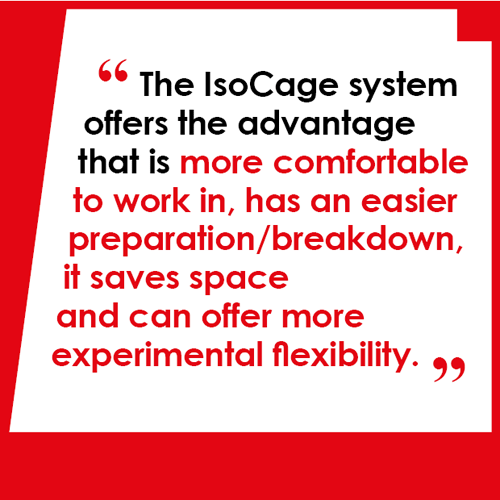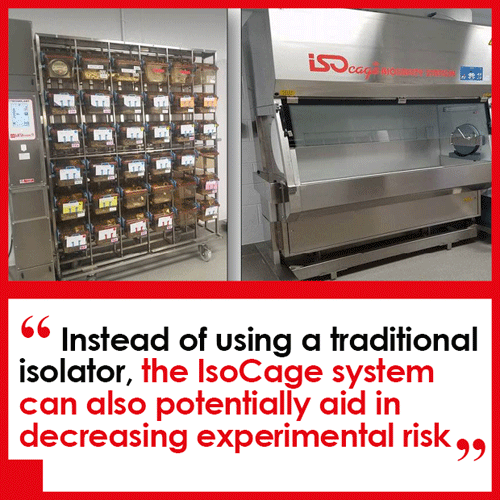
The current version of the Tecniplast website doesn't match your region. Please visit your local website to find information and offerings specific to your country.

The current version of the Tecniplast website doesn't match your region. Please visit your local website to find information and offerings specific to your country.

Leopoldo Zauner meets Jessica K. Lang, Sr.Research Specialist and Gnotobiotic Facility Manager
 I have seen your presentation titled “Technical Components of Managing a Gnotobiotic Facility” during an interesting seminar on Gnotobiotics at Aalas 2018 in Baltimore. Firstly, on behalf of the whole Tecniplast Group, let me make our compliments to you for the interesting and clear presentation you delivered. When did you start managing a Gnotobiotic facility?
I have seen your presentation titled “Technical Components of Managing a Gnotobiotic Facility” during an interesting seminar on Gnotobiotics at Aalas 2018 in Baltimore. Firstly, on behalf of the whole Tecniplast Group, let me make our compliments to you for the interesting and clear presentation you delivered. When did you start managing a Gnotobiotic facility?
Thank you! I have been working in the gnotobiotic field since 2010. I managed my first facility, at the University of Miami in 2012. In 2016, I opened a gnotobiotic facility at the Harvard T.H Chan School of Public Health.
Can you briefly describe the relationship you mentioned among “Ease of Use”, “Cost Effectiveness” and “Satisfaction”?
In any facility (Gnotobiotic or otherwise) there are important factors in order to have a successful operation. Ease of use relates to how “friendly” the equipment is - think ergonomically but also in terms of the actual SOPs as well. Cost is always factored into any purchase, of course, everyone wants to save money! Satisfaction goes hand in hand with all of these. However, without quality staff, none of these factors matter. A facility can have the highest tech equipment, the most beautifully written SOPs and remained within budget, but success comes down to having conscientious, competent and passionate staff.
We understand that, in your Facility, you have both Isolators and Iso Cage System. Do you adopt specific systems for specific research purposes (es. Diet studies or Gut Microbiota)?
We typically do our breeding in our isolators and our experiments, using the IsoCage system. This has been fruitful for us, in terms of labour and colony maintenance. Working in the isolators is more difficult from an ergonomic standpoint. Although many procedures are done in the isolators, you need to keep them pristine. The IsoCage system does not have the ergonomic and access issues and therefore, is a better experimental platform.
 Have you developed specific SOPs and health Status for both the two systems?
Have you developed specific SOPs and health Status for both the two systems?
We use different SOPs for the isolator and the IsoCaging systems - even the type of sterilant we use is different! However, regardless of health status, the mice are all treated the same on whichever system they are being housed in. For example, a monocolonized mouse is handled the same way as a germ free mouse in an IsoCage system.
Isolators vs IVCs: have you identified specific competitive advantages of one system vs the other?
The isolators work very well for breeding. We only open the port when we need supplies or if we are exiting animals. This system has proven to be a foolproof way for us to have a constant supply of mice.
The IsoCage system offers the advantage that it is more comfortable to work in, has an easier preparation/ breakdown, it saves space and can offer more experimental flexibility. You are not locked into a specific health status when working with the IsoCage system. Each IsoCage is its own mini isolator.
 Instead of using a traditional isolator, the IsoCage system can also potentially aid in decreasing experimental risk. We had an instance where an isolator became contaminated midway through an experiment (we suspect it was the solution being used in the study). Had that study been conducted on the IsoCage system in lieu of the isolator, there is a chance that not all animals would have been necessarily exposed to the contamination.
Instead of using a traditional isolator, the IsoCage system can also potentially aid in decreasing experimental risk. We had an instance where an isolator became contaminated midway through an experiment (we suspect it was the solution being used in the study). Had that study been conducted on the IsoCage system in lieu of the isolator, there is a chance that not all animals would have been necessarily exposed to the contamination.
Have you run a cost analysis of the two systems?
Not officially. Our facility is still relatively small (but growing!). I plan to do a thorough cost analysis in the near future. I can say that the upfront cost of the IsoCage system is greater than the isolator system. It is noteworthy to add that although the initial cost is increased you will likely regain cost back in terms of labour. Procedures are easier to perform in the IsoCage system, there is less prepwork involved, and the cage change frequency will decrease (we change the isolators once a week, and the IsoCages biweekly). The IsoCage system requires two people to effectively use the dunk tank, but realistically speaking a gnotobiotitc facility should never be a oneperson operation!
Leopoldo ZAUNER - Marketing Director